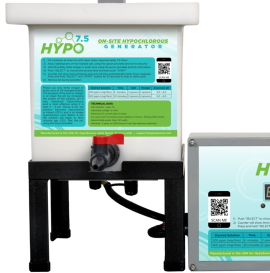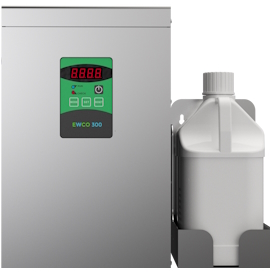Исследование > Микроб > Fungi > Aspergillus
Часто используемые названия для растворов хлорноватистой кислоты
- Electrolytically Generated Hypochlorous Acid
- Neutral Electrolyzed Water (NEW)
- Electrolyzed Oxidizing Water (EOW)
- Electro-chemically Activated Water (ECA)
- Super-oxidized water (SOW)
Результаты: 3 опубликованные статьи

Microbe(s): Staphylococcus aureus, Bacillus cereus, Escherichia coli, Aspergillus fumigatus
Application of slightly acidic electrolyzed water (SAEW) in combination with ultrasound for decontamination of kashk was investigated. SAEW had a pH of 5.3-5.5, an oxidation reduction potential of 545-600 mV, and an available chlorine concentration of 20-22 mg/L. Kashk is a dairy product with a unique aroma and a high nutritive value produced in Iran. A 2/1 SAEW/kashk ratio showed 1.42, 1.13, 1.24, and 1.37 log CFU/mL microbial reductions in Staphylococcus aureus, Bacillus cereus, Escherichia coli, and Aspergillus fumigatus, respectively, at room temperature. A combination of SAEW treatment with ultrasound (SAEWultrasound) resulted in 1.87, 1.67, 1.71, and 1.91 log CFU/mL reductions in S. aureus, B. cereus, E. coli, and A. fumigatus, respectively. The developed hurdle approach can be a useful tool for sanitization of kashk and similar products. Application of SAEWultrasound in dairy microbial decontamination is first reported herein.

Microbe(s): Aspergillus flavus, A. parasiticus, A. nomius, RE: Aflatoxin
Aflatoxins, a group of extremely toxic mycotoxins produced by Aspergillus flavus, A. parasiticus and A. nomius, can occur as natural contaminants of certain agricultural commodities, particularly maize. These toxins have been shown to be hepatotoxic, carcinogenic, mutagenic and casevere human and animal diseases. The effectiveness of neutral electrolyzed oxidizing water (NEW) on aflatoxin detoxification was investigated in HepG2 cells using several validation methodologies such as the 3-(4,5-dimethylthiazol-2-yl)-2,5-diphenyltetrazolium bromide assay, the induction of lipid peroxidation, the oxidative damage by means of glutathione modulation, the Ames test and the alkaline Comet assay. Our results showed that, after the aflatoxin-contaminated maize containing 360 ng/g was soaked in NEW (60 mg/L available chlorine, pH 7.01) during 15 min at room temperature, the aflatoxin content did not decrease as confirmed by the immunoaffinity column and ultra performance liquid chromatography methods. Aflatoxin fluorescence strength of detoxified samples was similar to untreated samples. However, aflatoxin-associated cytotoxicity and genotoxicity effects were markedly reduced upon treatment. According to these results, NEW can be effectively used to detoxify aflatoxin-contaminated maize.

Microbe(s): Fungi, Aspergillus parasiticus, aflatoxin B1
Electrolysis of a 0.1% (17.1 mM) solution of NaCl using separate anode and cathode compartments gives rise to solutions containing active chemical species. The strongly acidic anode solution (EW(+)) has high levels of dissolved oxygen and available chlorine in a form of hypochlorous acid (HOCl) with a strong potential for sterilization, which we have investigated here. Exposing Aspergillus parasiticus at an initial density of 103spores in 10 L to a 50-fold volume (500 L) of EW(+) containing ca. 390 mol HOCl for 15 min at room temperature resulted in a complete inhibition of fungal growth, whereas the cathode solution (EW( )) had negligible inhibitory effects. Moreover, the mutagenicity of aflatoxin B1 (AFB1) for Salmonella typhimurium TA-98 and TA-100 strains was strongly reduced after AFB1 exposure to the EW(+) but not with the EW( ). In high-performance liquid chromatography analysis, the peak corresponding to AFB1 disappeared after treatment with the EW(+), indicating decomposition of the aflatoxin. In contrast, the routinely used disinfectant sodium hypochlorite, NaOCl, of the same available chlorine content as that of EW(+) but in a different chemical form, hypochlorite (OCl-) ion, did not decompose AFB1 at pH 11. However, NaOCl did decompose AFB1 at pH 3, which indicated that the principle chemical formula to participate in the decomposition of AFB1 is not the OCl- ion but HOCl. Furthermore, because the decomposition of AFB1 was suppressed by pretreating the EW(+) with the OH radical scavenger thiourea, the chemical species responsible for the AFB1-decomposing property of the EW(+) should be at least due to the OH radical originated from HOCl. The OH in EW(+) was proved by electron spin resonance analysis.
Best Hypochlorous Acid (HOCL) Generators
 Portable Hypochlorous Acid (HOCL) Machine
Portable Hypochlorous Acid (HOCL) Machine
Make high quality hypochlorous acid in the home or office.
$159.99 + Free Shipping
 HOCL Machine + Electrostatic Sprayer
HOCL Machine + Electrostatic Sprayer
Make hypochlorous acid and spray with an electrostatic cold fogger.
$309.98 + Free Shipping


